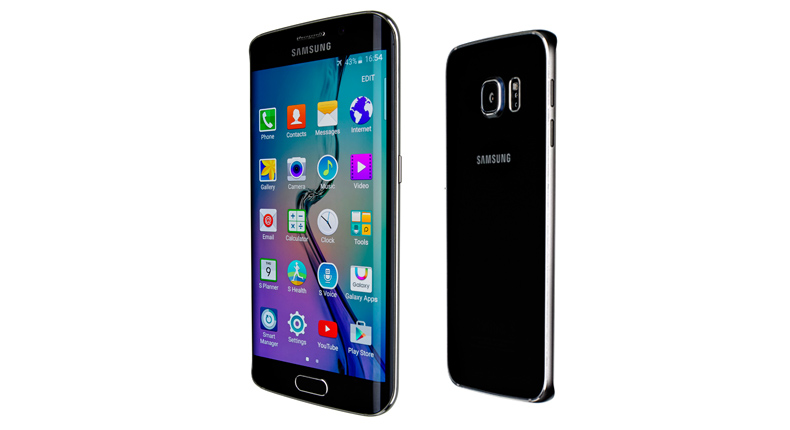It’s been three years since we’ve given a phone in the Samsung Galaxy S family five stars, but after just a few minutes with the Galaxy S6 Edge, we already get the feeling that’s about to change.
We weren’t always so sure. When we first heard about the Edge, we were sceptical. Almost identical to the Galaxy S6 in terms of spec, with just its curved screen separating them, was their really any point to it?
That was before we saw it. The S6 Edge really is something you have to pick up and feel in your hand to really appreciate. As innovative as it is desirable, this is the phone we’ve been waiting for from Samsung, and a phone that’s only impressed us the longer we’ve spent with it.
Design
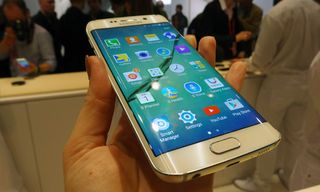
There’s no doubt that the S6 Edge is a premium handset – unabashedly so, and with a price tag to match. It follows the lead of Samsung’s Galaxy Note 4 Edge, but takes it one step further, with a screen that wraps around both vertical edges of the phone, rather than just one.
This makes it feel even slimmer than it is, with the trade off that its edges feel slightly sharp in the hand, compared to the smooth edges of its straight-laced sibling. Whether this bothers you will be personal preference – we certainly didn’t find it uncomfortable, and in fact found it easier to grip.
In a long-awaited first for the Galaxy S range, the S6 Edge ditches the plastic body in exchange for one with a metal frame and Corning Gorilla Glass 4 on the front and back.
The result is a much higher-quality look and feel, but a handset that is more prone to fingerprint smudges.
It’s also now a unibody design, which means power users lose the ability to swap out the battery – and Samsung has also nixed the ability to expand the storage via microSD.
Instead it now offers iPhone-like built-in storage options of 32GB, 64GB and 128GB. While the ability to swap out your battery won’t be a feature missed by the majority of users, the loss of the microSD card slot probably will, and it’s a shame to see Samsung make a compromise on such a key feature.
Screen
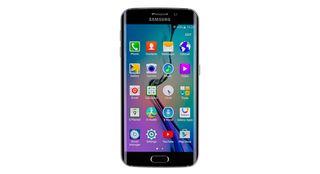
All is forgiven with one glance at the S6 Edge’s screen though. Curved edges aside, it’s a gorgeous 5.1in Super AMOLED Quad HD (2560 x 1440) display with 577ppi – some 77 per cent more pixels than the Galaxy S5.
Of course, those curves can’t be ignored for too long, and it’s those that make the S6 Edge one of the best-looking phones on the market.
There’s little more reason to them than that – sure there are a few software tweaks that set it apart from the standard S6 (more on those later), but the primary reason you’d choose the S6 Edge’s more curvaceous outline is because it looks so good.
Those curves really add something to a movie watching experience too. It’s almost entirely bezel free, and as the image spills over the edges, it only helps make for a more immersive experience.
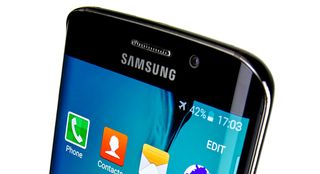
As for the screen itself, with a Quad HD display and more pixels per inch than most handsets on the market, there’s no surprise that it’s a beauty. Pictures are crisp and full of detail, with outlines sharp and defined.
The AMOLED display means viewing angles aren’t the best, and colours can look a little washed out off axis, but when viewed straight on, you’ll find them punchy and bright.
You’ll still get the most natural hues from the likes of the iPhone 6, but the S6 Edge is far from overdone, plus you have a handful of viewing modes that help you choose a colour palette to suit your preference.
Where the AMOLED screen falls down a touch on viewing angles, it comes into its own on contrast. The S6 Edge offers seriously deep blacks alongside bright whites that have the ability to punch through dark scenes, while still maintaining detail levels. The whites can have a slightly bluey tinge to them, but it’s not something we find overly noticeable during normal viewing.
Audio
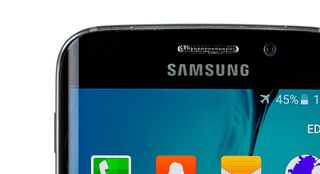
The Galaxy S6 Edge offers music playback up to 24-bit/192kHz. High-res tracks are handily tagged up with a UHQ logo and their bitrate, with a wide range of formats accepted including FLAC and WAV.
High-res tracks and Spotify streams alike are filled with punch and attack, timing well and offering plenty of detail across the frequency range. It’s a refined sound, leaner in tone to that on the iPhone 6, but one that is also dynamic and tonally balanced.
Higher res tracks have a touch more subtlety to instruments, and an increased sense of space around big orchestral tracks, though Sony’s Xperia Z3 still delivers vocals with a touch more expression.
This is easily one of the best sounding Samsung phones we’ve ever heard, delivering a thoroughly enjoyable listen no matter the track or genre.
Performance

The S6 Edge packs Samsung’s own 64-bit octa-core Exynos processor that promises a performance 20 per cent faster and 35 per cent more efficient than that of the already pretty nippy Note 4. There’s also 3GB of ultra-fast RAM to help keep things moving along without delay.
The result is a slick performance that barely stutters even when fed the most graphic-intensive games we could throw at it. Samsung’s Touchwiz interface could still be a touch lighter, but there’s been plenty done in an attempt to slim it down, including a cleaner design across the board and less bloatware overrunning the app tray.
Even better, the Samsung apps that are installed can now be disabled, removing them from view and keeping them out of your way should you wish (though not deleting them entirely).
The edges have a few tricks of their own built into the interface, but they don’t really add much to the experience. You can have one interactive edge; once you’ve picked which side you want to use, you can build five favourite contacts to sit in a menu that is opened by swiping from that side.

These contacts each have a colour attached to them (all customisable), and the S6 Edge will glow that colour when that person calls – but only if the handset is lying face down. It’s rather specific and we’re not sure how often it would be used, though the favourite contacts menu is quite handy.
Another feature is Information Stream. With this, you can swipe a finger up and down the edge while the screen is locked to check time, weather, notifications and a handful of other updates on a slim ticker-style scrolling wheel.
The idea is to avoid lighting up that powerful screen every time you want to check your notifications – but the swiping motion was often so temperamental in loading Information Stream that we barely found ourselves using it.
Hopefully Samsung can work on this and find ways of making the edges of the S6 Edge more than just a pretty face.
Battery life
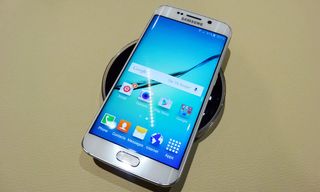
Waterproofing has been taken off the menu with the S6 Edge. This year, the focus falls on battery life and charging.
Wireless charging is built in to the handset, with quick recharge times also on the menu. Samsung’s quick-charge plug comes as standard, and as you’d expect, we see a boost in charging with it compared to a standard charger, particularly when charging from flat.
Samsung says you’ll get around four hours of everyday use with just 10 minutes of charge. Plug it in with the battery flat and you’ll be able to turn the handset on immediately, with our sample jumping to 12 per cent in 10 minutes.
This speedy charging makes most impact when the battery is low, levelling out a little as it gets more full – but it’s a handy feature all the same. However despite this, we can’t help but want a little more from its battery life, particularly after the strong performances of some of 2014’s handsets.
With its bright, powerful screen, the S6 Edge struggles to make it through a full day without crying out for a charger, managing around 10 and a half hours on our battery run-down test, looping a 720p video on 50 per cent brightness.
Samsung’s power-saving modes are good and worth trying out if you’re ever stuck. The ultra power-saving mode is really impressive in its ability to eke out hours of (limited) use from just a few per cent of battery life remaining.
Features

The fingerprint sensor and heart rate monitor from the S5 return on the S6 Edge, with the former being hugely improved over its predecessor.
Previously you had to make a rather awkward swiping motion over the home button to have your fingerprint read. It’s now much easier, with you simply resting your finger over the top, as you do on the iPhone.
We don’t find it to be quite as foolproof as Apple’s scanner when it comes to absolute accuracy, but it’s close, and makes fingerprint unlocking a real option on a Samsung device for the first time ever.
Camera
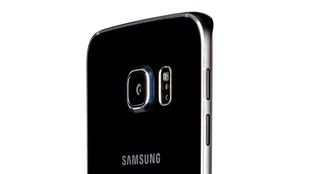
The main camera on the Galaxy S6 Edge packs the same 16MP sensor as the S5, but this time features an improved f/1.9 aperture for better low-light shots.
This f/1.9 aperture has also made its way on to the 5MP front-facing snapper too, and promises a 43 per cent increase in pixel size – very important for grabbing more light in badly lit situations.
Not just this but the camera is now really quick to launch too, with a double tap on the home button opening the camera app in a seriously snappy 0.7 seconds.
Like the rest of the interface, the whole camera experience has been tidied up and decluttered. The auto mode will be fine for most people, but those looking for a little more creative control might prefer the Pro mode, which gives you the ability to tweak exposure, ISO, white balace and the like.
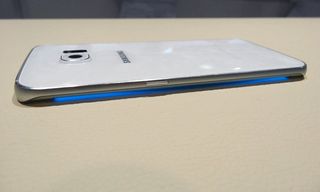
Last year’s Selective Focus returns here, offering you the ability to achieve a DSLR-like depth of field to your pictures and achieving much better results than the HTC One M9’s similar mode. Shots are believable, with the subject in the foreground sharp and in focus, while the background is artfully blurred (or vice versa if you prefer).
Used outside in good light, the S6 Edge’s camera is up there as one of the best, capturing stacks of fine detail, even on zoomed in shots, and doing an excellent job with colour reproduction.
Autofocus is fast and accurate and the built-in optical image stabilisation (OIS) ensures shots are sharp and blur-free, even in low-light situations.
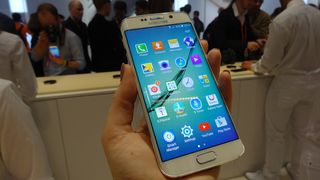
Combine its OIS capabilities with the f/1.9 lens and the S6 Edge doesn’t do a bad job in low light at all, though autofocus might need a bit of a helping hand to ensure it’s concentrated on the right thing.
The automatic HDR mode also does a grand job in tricky outdoor lighting situations, convincingly lifting detail from shadows without overblowing lighter areas of the image.
On the video side of things, you can capture Full HD footage with optical image stabiliation, or 4K video without it, while the slow-motion and fast-motion options will only record in a maximum of 720p.
The lack of OIS for 4K video can lead to slightly shaky handheld footage, and we preferred to take the drop in resolution for a steadier shot.
Verdict
With the release of the S6 Edge, Samsung has proven that it is once more back on its A game, producing a phone that offers a stunning design alongside a stonking performance.
There is the small matter of the price, though. At £700 for the 32GB version, it’s around £100 more expensive than the regular S6, for an experience that is almost identical. If the curved screen isn’t a draw for you, then the S6 may well be a better option.
However, it is the screen here that makes the S6 Edge feel so special – and it’s a feeling we think could make more people plump for the Edge than Samsung might have first thought.
It’s not without its flaws of course – we’d like a stronger battery life and a microSD card slot, but its overall performance helps us to forget those.
We know the S6 Edge is Samsung simply showing off what it can do, but who can complain when it can do things like this. It’s a truly excellent handset that takes Samsung’s flagship Galaxy S phone range comfortably back to five-star glory.
